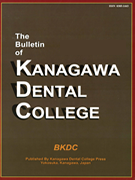- HOME
- > 一般の方
- > バックナンバー:The Bulletin of Kanagawa Dental College
- > 25巻2号
- > アブストラクト
アブストラクト(25巻2号:The Bulletin of Kanagawa Dental College)

English
| Title : | Blockade of Ischemic Preconditioning by Glibenclamide in Rabbits Anesthetized with Sevoflurane |
|---|---|
| Subtitle : | ORIGINAL ARTICLES |
| Authors : | Hideyuki Sawada, Kazu-ichi Yoshida, Rakesh C.Kukreja1 |
| Authors(kana) : | |
| Organization : | Department of Anesthesiology, Kanagawa Dental College, 1Division of Cardiology, Medical College of Virginia, Virginia Commonwealth University |
| Journal : | The Bulletin of Kanagawa Dental College |
| Volume : | 25 |
| Number : | 2 |
| Page : | 65-71 |
| Year/Month : | 1997 / 9 |
| Article : | Original article |
| Publisher : | Kanagawa Odontological Society |
| Abstract : | [Abstract] The mechanism of the protective actions of myocardial ischemic preconditioning has not been clearly elucidated. Recently, it has been reported that the end effector of preconditioning (PC) could possibly be the ATP-sensitive potassium (KATP) channel. This channel has been implicated as one of the potential mechanisms of myocardial protection by halogenated volatile anesthetics including isoflurane and halothane associated with ischemia and reperfusion. This study was designed to assess the effect of sevoflurane on the intensity of myocardial response to preconditioning following ischemia and reperfusion. A second goal of this investigation was to determine whether blockade of KATP channels with glibenclamide (Glib) abrogates the protection afforded by PC in sevoflurane anesthetized rabbit hearts. In situ rabbit hearts (n=37) received regional ischemia by 30 min. of the left anterior descending artery occlusion followed by 3 hr of reperfusion under ketamine/xylazine (KX control) or sevoflurane (Sevo) anesthesia. Both groups (KX control and Sevo) were preconditioned by a 5 min. of ischemia followed by 10 min. of reperfusion prior to sustained ischemia. Glibenclamide (0.3 mg/kg in 0.3 ml/kg vehicle) was administered as intravenous bolus 15 min. prior to ischemic preconditioning. Infarct size was determined by tetrazolium staining. The areas at risk ranged from 44.2+-82% to 71.0+-9.0% with no significant difference among all the groups. Infarct size was 49.1+-4.7% in ketamine-xylazine anesthetized control rabbits; decreased significantly to 7.3+-0.5% in the PC hearts. In sevoflurane anesthetized rabbits, PC produced protection against ischemia reperfusion only in regard with infarct size. The infarct size between KX+PC and Sevo+PC was not significantly different. Thus ischemic preconditioning in rabbits anesthetized with ketamine/xylazine offered protection similar to that seen in sevoflurane anesthetized rabbits. Treatment with glibenclamide of preconditioned rabbits resulted in a significant increase in the infarct size (40.0+-3.7% in KX+Glib+PC, 38.8+-4.8% in Sevo+Glib+PC). Glibenclamide by itself had no apparent effect on infarct size in non-preconditioned rabbits (46.7+-5.0% in KX+Glib and 38.7+-12.4% in Sevo+Glib). These data suggest that myocardial protection afforded by sevoflurane during ischemia and reperfusion, at least, may be due to KATP activation and that myocardial protection with preconditioning is preserved under sevoflurane anesthesia in the rabbit heart. |
| Practice : | Dentistry |
| Keywords : | ATP-sensitive potassium channel, Ischemic preconditioning, Myocardial protection, Sevoflurane |
